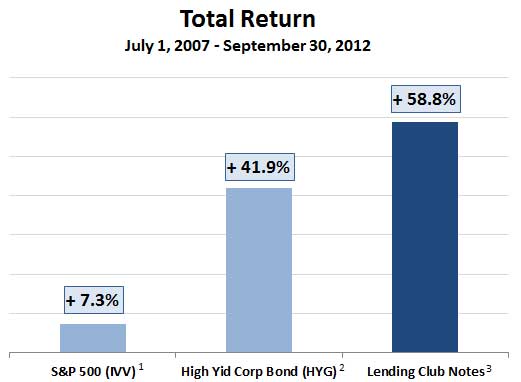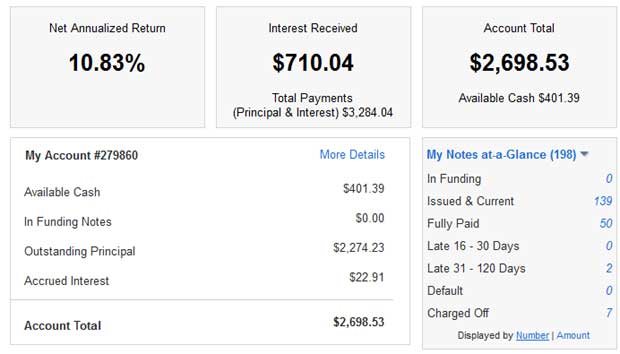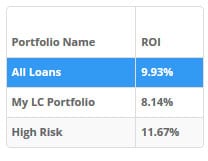Lending Club has now been around for just over 5 years, and as of November of 2012 has originated over $1 billion dollars in personal loans given to borrowers. That’s quite the meteoric rise for a company and investing platform that didn’t even exist a few years ago!
Now that Lending Club has been around for a few years we’re starting to see some trends when it comes to performance of Lending Club investments versus the performance you’d see in the stock market. In a recent post Lending Club compared their average returns with those of the S&P 500 over the past 5 years, as well as a representative High Yield Corporate Bond ETF.
What you can see from the data is that Lending Club Notes have had higher total returns, higher average returns, and higher minimum returns than the S&P 500 and a representative index of high-yield corporate bonds.
True, there weren’t any massive one-year returns with Lending Club Notes, but neither were there any one-year slumps. Instead, over the past five years, Lending Club Notes have provided consistent returns for investors from 8.5% to 10.1% annually.
In fact, 93% of Lending Club investors with 800+ Notes earn net annual returns between 6% and 18%, and 100% of investors with 800+ Notes have experienced positive returns. (800 Notes can be purchased with a minimum investment of $20,000).
After A Bad Few Months, Lending Club Returns Now Near 11%
Over 98.9% of all investors with 100 or more Notes have experienced positive returns. 100 Notes can be purchased with a minimum investment of $2,500.
So how have my returns been doing since my last update a few months ago? Last summer my Lending Club returns topped 12% for the first time. At one point my returns were north of 12.22%, definitely better than any returns I’ve seen in my 401k or other investments over the past few years.
After I topped 12.22% in my net annualized return last fall, however, I started to have a few loans go late. I knew that with my investing strategy of investing in more low grade, higher interest loans I should expect to see a few charged off loans here and there. Up until a few months ago, however, I’d had only one loan go bad over several years. I guess I was lucky, because in the past few months I’ve had several all at once.
First, I had one of my borrowers die, and his loan was quickly charged off. Then a glut of 4-5 others went late. I’m now at a point where I have a total of 7 charged off loans. I guess they come in bunches.
Even with the defaults, I’m still seeing decent returns and my losses were somewhat mitigated in that several of the charged off loans had much of the balance paid off already.
- Net Annualized Return of 10.83%: My last few Lending Club reports have showed increasing returns with my Lending Club account, and since my last report I had several charged off loans. So my net annualized returns have gone from 12.22% last fall to 10.83% today. My returns are still up from the 10.53% it was a year or so ago.
- Number of defaults. Seven charged off, with 2 late: I’ve got 7 charged off loans with about $109 in outstanding principal unpaid, mainly on a couple of the non-aged loans. There is one A, two B, two C a D and an E loan charged off. The late loans are a B and a D, so if you look at the grades of my late and defaulted loans, they seem to be pretty spread out. That doesn’t give me much reason to get away from my strategy of investing in lower graded loans, especially if the higher graded ones are almost as likely to default.
- Fifty loans have been paid off early: Nineteen were A grade loans, fifteen were grade B loans, nine were C grade, two grade D, three grade E and two F. Looks like grade A and B loans are more likely to get paid back early, reducing returns. The earlier a loan is paid off, the less likely you are to be making money, and in some cases you may actually lose money! Another reason to consider investing in lower grade loans.
- I’m diversified by investing small amounts across multiple loans: I’ve had 198 loans since joining (139 issued and current loans, 50 paid off), with no more than $25 in each loan. In other words, I’m diversified across a decent amount of loans, lessening my risk from any one loan going into default or getting charged off. Of course to be fully diversified I believe Lending Club recommends 800 or more notes. I’m not there yet, and won’t be until later when we’ve finished saving up a down payment for a home.
Open Your Lending Club Account Today
What’s Your Actual ROI?

Nickel Steamroller’s Lending Club portfolio analyzer, which has recently been re-designed a bit, does a better job of giving you an idea of your actual ROI. Basically the analysis tool with give you an estimated ROI after you download all your notes from your Lending Club account and upload the .csv file. It will go through you notes and give sell recommendations, show duplicate notes and highlight notes that are below Lending Club’s average return (so you can sell them on the secondary platform). It will even give you a fun little map showing where your loans are (see mine above).
In looking at my returns on the analyzer, my actual return according to the site will be closer to 9.93%. It also gives me quite a few sell recommendations, particularly on some of my older lower interest loans that I did when first starting out. Those particular loans tend to be grade A or B, and have interest below 8%. I’m sticking with some of them for now, but down the road I may lean more towards the lower grade loans in my portfolio.
Evolving Lending Club Strategy
Here’s the basic strategy I’ve been using with Lending Club since I started investing. The strategy has changed a little bit over time to include more low grade loans and a few loans with higher balances.
- Less than $10,000: I believe I’ll still be sticking with mostly loans below $10,000. Lower amounts mean higher likelihood of payback of the loan.
- Zero delinquencies: Again, I may fudge slightly on this one, but I still want it to be very few or zero delinquencies.
- Debt to income ratio below 20-25%: I like to invest in loans where the borrowers have a lower DTI ratio, and preferably have higher incomes. I’ll try to keep this as is.
- Good employment history: I like loans with a decent employment history of at least 2 years, and a decent income.
So that’s what I’m doing with my Lending Club portfolio right now, and how I’m investing.
Not ready to invest, but looking to consolidate debt or pay off a high interest credit card? You might want to consider borrowing from Lending Club. Check out my post on borrowing from Lending Club.
Are you currently investing in Lending Club? How are your returns looking? Tell us in the comments!





Even though you have had some setbacks with charge-offs, a combined 9.93% return on investment isn’t too shabby! Good luck with your continued transition to higher interest loans!
Mine are in the double digits.
From a moral angle, as Christians doesn’t lending money seem opposite of what the Bible teaches? We have only one God, but when we make someone else a slave, that person may have to make money a priority over God?
I don’t think the Bible completely teaches that we should never lend money.
Here’s an article on Christians lending on another site that speaks to my thoughts on the issue. Basically, giving someone a loan can in fact help them at times and be compassionate. Of course at other times it can also be greedy or predatory lending. It is up to you as the lender to “conduct his affairs with justice” and ensure that your lending is in fact helping someone (to the best of your knowledge), and that the loan terms are reasonable, etc.
Personally I try to look at the loans I’m giving on Lending Club and ensure that the people are getting the loans for reasons I can agree with – or that the loan will be helping the person get out of another more predatory loan.
other verses that talk about the lord’s view against lending:
“The primary scriptural basis for the universal patristic denunciation of lending money at interest comes from four sources,
“Ex. 22:25 ¶ If you lend money to my people, to the poor among you, you shall not deal with them as a creditor; you shall not exact interest from them.”
“Deut. 23:19 ¶ You shall not charge interest on loans to another Israelite, interest on money, interest on provisions, interest on anything that is lent.”
“Psa. 15:1, 5 O LORD, who may abide in your tent? Who may dwell on your holy hill? … (those) who do not lend money at interest, and do not take a bribe against the innocent.”
“Luke 6:34 If you lend to those from whom you hope to receive, what credit is that to you? Even sinners lend to sinners, to receive as much again.”
Other verses cited include Leviticus 25:36-37, Jeremiah 5:7, Jeremiah 5:10, Proverbs 28:8, Isaiah 24:2, Jeremiah 15:10, Ezekiel 18:8, Ezekiel 18:13, Ezekiel 18:17, Ezekiel 22:12 and Matt 6:19-21.” Quoted from an article here: http://www.askthepriest.org/askthepriest/2005/10/never_a_borrowe.html
The church did change it’s stance on lending and the bulk of the middle of the article talks about the why’s and how’s of that change over the centuries. Actually a very enlightening read. The author is using this change in belief of the church on usury (charging interest) to justify a way for the church to change its belief on homosexuality, so for those not interested in that part of the discussion, skip the first paragraph.
I have had a similar experience with Lending Club returns. With the stock market so high right now I am moving money out of stocks and counting on my Lending Club investment to provide continued high returns. Hopefully P2P lending will remain a solid investment even in a recession.
Hello Peter,
I’ve been investing with Lending Club for about 3 years. I also had very high returns early on. However a chart that may not have been available to you at the time showed that those returns drop over time as loans mature and many more get charged off.
I’m 64, done financial counseling and seminars over the past 40 years. My parameters are similar to yours although I’m not as concerned about the total loans. Much more important in my opinion is the ratio between total loans and monthly income. The highest I accept is a loan amount just over 2 months income.
I have over 7000 loans, average age of 18 months, weighted average loan at 15% and my return is currently at 6.15%. That puts me in roughly the 95 percentile for people who have over 1000 loans. A typical investor without my experience can expect a return of 4-5%.
See http://www.lendingclub.com/investing/investment-performance
Over time, Lending Club won’t compete with the S&P. That said, it’s a great way to diversify. At current stock values, Lending Club has outperformed the S&P in the short term.
As you know, money is tied up, with about 1/20th of the funds becoming available monthly. It should be considered as an alternative to a 2 year CD.
God Bless,
Loan defaults for Lending Club loans have been incredibly low since mid-2020. This has resulted in historically high returns. Too bad they stopped allowing investors to purchase loans early last year.